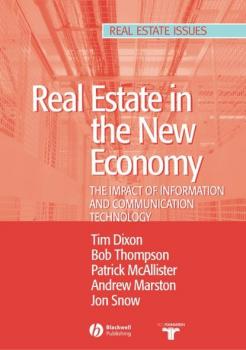ТОП просматриваемых книг сайта:
Tim Dixon
Список книг автора Tim DixonАннотация
Private sector commercial property represents some £400 bn, or 34% of total UK business assets and is a vital fabric for housing commercial enterprise. Yet social and economic forces for change, linked with new technology, are making owners and occupiers question the very nature and purpose of property and real estate. Printing, steam power; canals and railroads; mass media and, more recently, information and communications technology (ICT) have brought about major changes in both organisational and economic structures over the centuries. On the one hand, there has been much hype about the role that ICT would play in eliminating the need for physical real estate space; and on the other, some have suggested that institutional factors and fixed costs mitigate against transformative change in real estate. Building on the authors' own research and a growing body of new, international findings in the field, the book provides a balanced view between these two positions. It will demonstrate how ICT affects the shape and form of real estate in our towns and cities, with other forces in the new economy. The book: examines how ICT and organisational change, combined with social, political and economic factors, affects real estate space demand analyses how real estate strategies are changing to reflect these trends shows how technology affects the geography and space of real estate and infrastructure in our towns and cities investigates future urban shape and form.
Аннотация
A groundbreaking exploration of the most promising new ideas for creating the sustainable cities of tomorrow The culmination of a four-year collaborative research project undertaken by leading UK universities, in partnership with city authorities, prominent architecture firms, and major international consultants, Retrofitting Cities for Tomorrow's World explores the theoretical and practical aspects of the transition towards sustainability in the built environment that will occur in the years ahead. The emphasis throughout is on emerging systems innovations and bold new ways of imagining and re-imagining urban retrofitting, set within the context of ‘futures-based’ thinking. The concept of urban retrofitting has gained prominence within both the research and policy arenas in recent years. While cities are often viewed as a source of environmental stress and resource depletion they are also hubs of learning and innovation offering enormous potential for scaling up technological responses. But city-level action will require a major shift in thinking and a scaling up of positive responses to climate change and the associated threats of environmental and social degradation. Clearly the time has come for a more coordinated, planned, and strategic approach that will allow cities to transition to a sustainable future. This book summarizes many of the best new ideas currently in play on how to achieve those goals. Reviews the most promising ideas for how to approach planning and coordinating a more sustainable urban future by 2050 through retrofitting existing structures Explores how cities need to govern for urban retrofit and how future urban transitions and pathways can be managed, modeled and navigated Offers inter-disciplinary insights from international contributors from both the academic and professional spheres Develops a rigorous conceptual framework for analyzing existing challenges and fostering innovative ways of addressing those challenges Retrofitting Cities for Tomorrow's World is must-reading for academic researchers, including postgraduates insustainability, urban planning, environmental studies, economics, among other fields. It is also an important source of fresh ideas and inspiration for town planners, developers, policy advisors, and consultants working within the field of sustainability, energy, and the urban environment.
Аннотация
A deep understanding of the implications of green roof retrofit is required amongst students and practitioners to make the decisions and take the actions needed to mitigate climate changes. Green Roof Retrofit: building urban resilience illustrates the processes undertaken to develop this new knowledge and thereby embed a deeper level of understanding in readers.Illustrative case studies and exemplars are drawn from countries outside of the core researched areas to demonstrate the application of the knowledge more broadly. Examples are used from the Americas (North and South and Canada), Oceania, Asia and other European countries.The book describes the multiple criteria which inform decision making and how this provides a way forward for making better decisions about green roof retrofit in different countries and climates.



